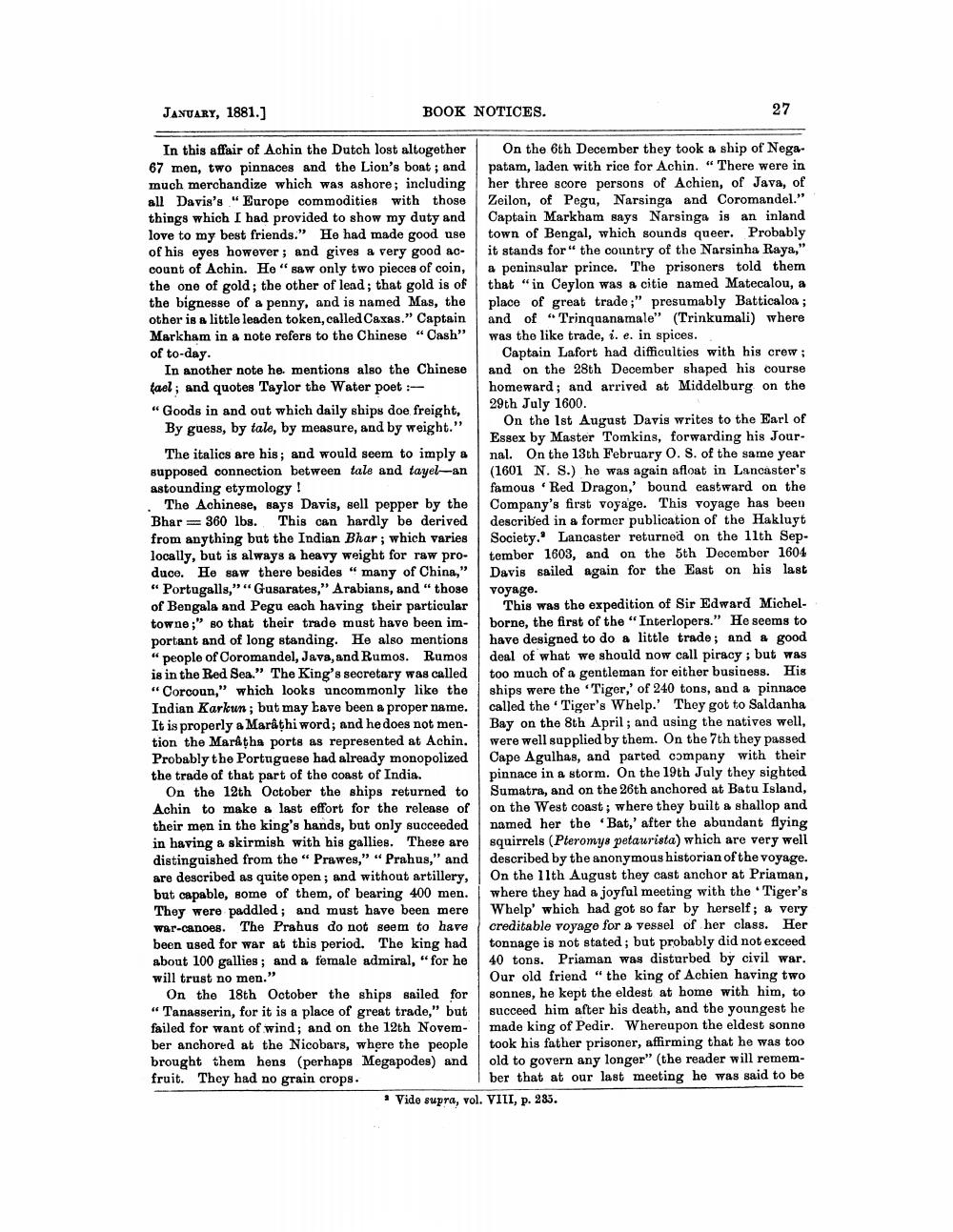________________
JANUARY, 1881.]
In this affair of Achin the Dutch lost altogether 67 men, two pinnaces and the Lion's boat; and much merchandize which was ashore; including all Davis's " Europe commodities with those things which I had provided to show my duty and love to my best friends." He had made good use of his eyes however; and gives a very good account of Achin. He "saw only two pieces of coin, the one of gold; the other of lead; that gold is of the bignesse of a penny, and is named Mas, the other is a little leaden token, called Caxas." Captain Markham in a note refers to the Chinese "Cash" of to-day.
BOOK NOTICES.
On the 6th December they took a ship of Negapatam, laden with rice for Achin. "There were in her three score persons of Achien, of Java, of Zeilon, of Pegu, Narsinga and Coromandel." Captain Markham says Narsinga is an inland town of Bengal, which sounds queer. Probably it stands for" the country of the Narsinha Raya," a peninsular prince. The prisoners told them that "in Ceylon was a citie named Matecalou, a place of great trade;" presumably Batticaloa; and of "Trinquanamale" (Trinkumali) where was the like trade, i. e. in spices.
Captain Lafort had difficulties with his crew; and on the 28th December shaped his course homeward; and arrived at Middelburg on the 29th July 1600.
On the 1st August Davis writes to the Earl of Essex by Master Tomkins, forwarding his Journal. On the 13th February O. S. of the same year (1601 N. S.) he was again afloat in Lancaster's famous Red Dragon,' bound eastward on the Company's first voyage. This voyage has been described in a former publication of the Hakluyt Society. Lancaster returned on the 11th September 1603, and on the 5th December 1604 Davis sailed again for the East on his last voyage.
"
This was the expedition of Sir Edward Michelborne, the first of the "Interlopers." He seems to have designed to do a little trade; and a good deal of what we should now call piracy; but was too much of a gentleman for either business. His ships were the Tiger,' of 240 tons, and a pinnace called the Tiger's Whelp.' They got to Saldanha Bay on the 8th April; and using the natives well, were well supplied by them. On the 7th they passed Cape Agulhas, and parted company with their pinnace in a storm. On the 19th July they sighted Sumatra, and on the 26th anchored at Batu Island, on the West coast; where they built a shallop and named her the 'Bat,' after the abundant flying squirrels (Pteromys petaurista) which are very well described by the anonymous historian of the voyage. On the 11th August they cast anchor at Priaman, where they had a joyful meeting with the 'Tiger's Whelp' which had got so far by herself; a very creditable voyage for a vessel of her class. Her tonnage is not stated; but probably did not exceed 40 tons. Priaman was disturbed by civil war. Our old friend "the king of Achien having two sonnes, he kept the eldest at home with him, to succeed him after his death, and the youngest he made king of Pedir. Whereupon the eldest sonne took his father prisoner, affirming that he was too old to govern any longer" (the reader will remember that at our last meeting he was said to be Vide supra, vol. VIII, p. 235.
In another note he. mentions also the Chinese tael; and quotes Taylor the Water poet :"Goods in and out which daily ships doe freight, By guess, by tale, by measure, and by weight."
The italics are his; and would seem to imply a supposed connection between tale and tayel-an astounding etymology!
The Achinese, says Davis, sell pepper by the Bhar 360 lbs. This can hardly be derived from anything but the Indian Bhar; which varies locally, but is always a heavy weight for raw produce. He saw there besides " many of China," "Portugalls,""Gusarates," Arabians, and "those of Bengala and Pegu each having their particular towne;" so that their trade must have been important and of long standing. He also mentions "people of Coromandel, Java, and Rumos. Rumos is in the Red Sea." The King's secretary was called "Corcoun," which looks uncommonly like the Indian Karkun; but may have been a proper name. It is properly a Marathi word; and he does not mention the Maratha ports as represented at Achin. Probably the Portuguese had already monopolized the trade of that part of the coast of India.
On the 12th October the ships returned to Achin to make a last effort for the release of their men in the king's hands, but only succeeded in having a skirmish with his gallies. These are distinguished from the "Prawes," "Prahus," and are described as quite open; and without artillery, but capable, some of them, of bearing 400 men. They were paddled; and must have been mere war-canoes. The Prahus do not seem to have been used for war at this period. The king had about 100 gallies; and a female admiral, "for he will trust no men."
27
On the 18th October the ships sailed for "Tanasserin, for it is a place of great trade," but failed for want of wind; and on the 12th November anchored at the Nicobars, where the people brought them hens (perhaps Megapodes) and fruit. They had no grain crops.




